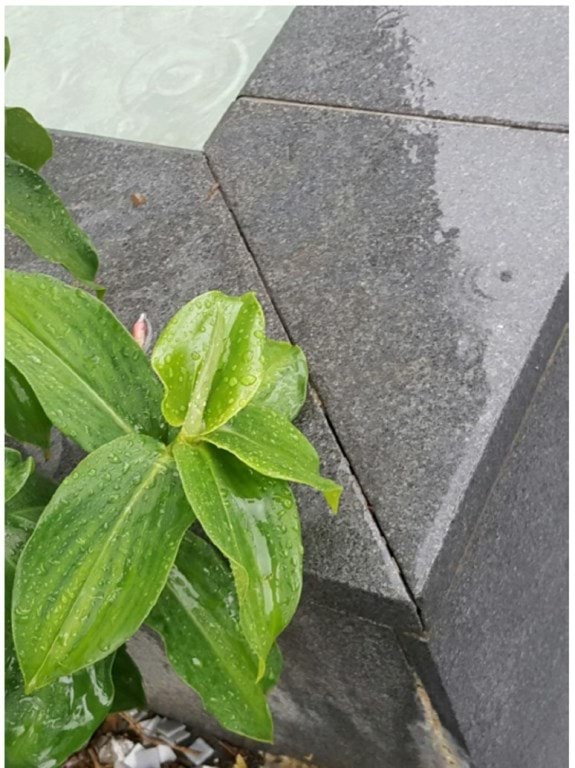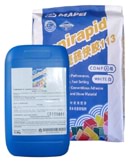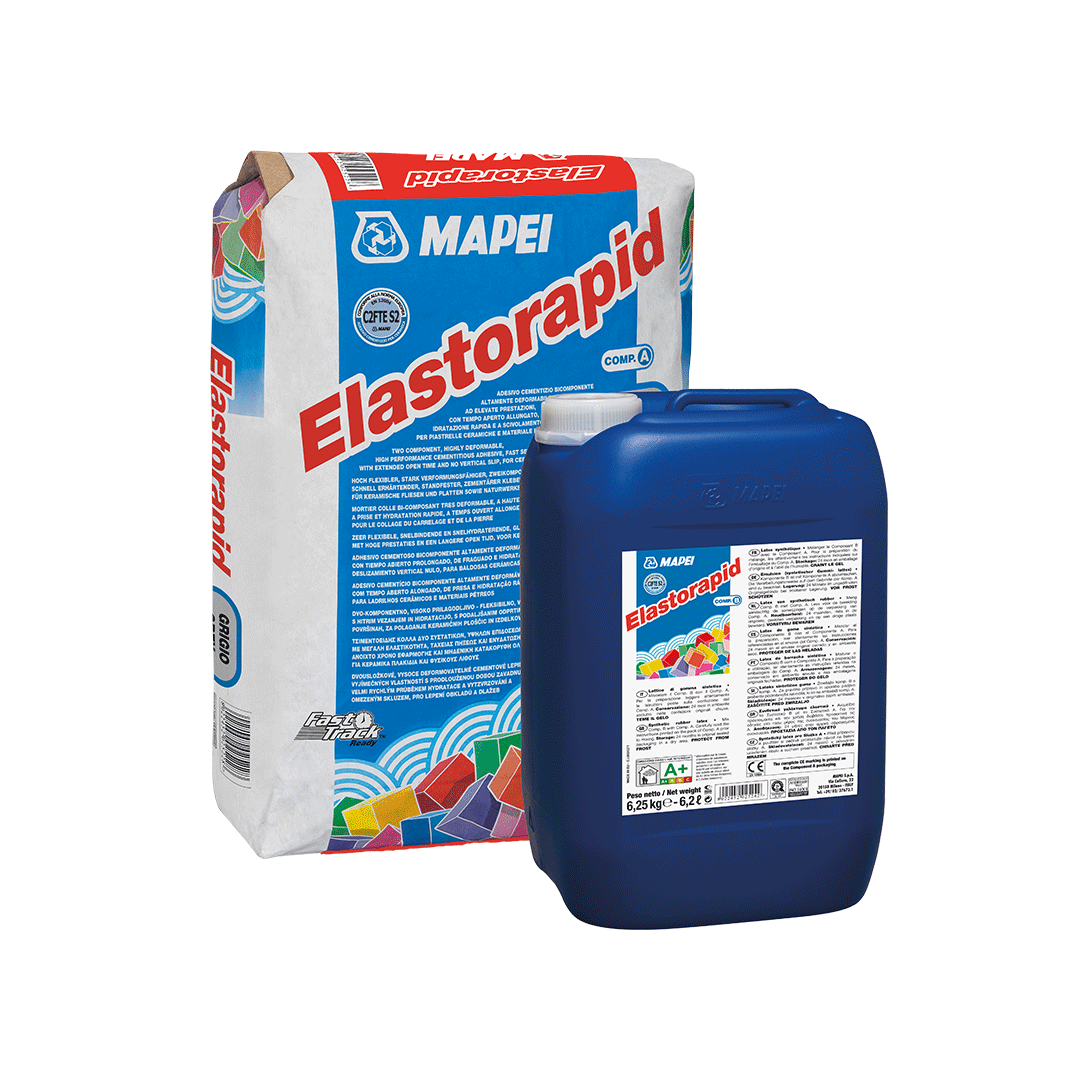How To Protect Tub During Tile Installation
Tips to forbid efflorescence during tile and stone installation
Apr 27, 2022, 03:55 AM past Cynthia Chong
Tips to preclude efflorescence during tile and rock installation
April 27, 2022. iii:55 AM
What is Efflorescence?
Have you e'er noticed white deposits on the wall and floor surfaces of your tile or rock installations? This white residuum is the result of efflorescence. Efflorescence is a natural occurrence in Portland cement applications. All Portland-cement based products, which are present in render and screed mortars and most cementitious adhesives, volition accept this presence of calcium hydroxide crystals after the hydration process. Efflorescence usually arises from the percolation of h2o through the cement-based backing that leaches out soluble salts, which are then deposited on the surface through the joints. The leached lime, when exposed to the atmosphere, will react with carbon dioxide to form calcium hydroxide crystals. To put it simply, the presence of water, travelled through a water path in contact with the calcium salts present in cement-based products, is drawn out to the surface through the capillary pores of the cementitious tile grout. One time the water evaporates, information technology leaves behind a white residue. Efflorescence is harmless, but unsightly, and can occur on both vertical and horizontal surfaces.
What causes Efflorescence?
A combination of three factors crusade efflorescence:
- Soluble salts nowadays in cementitious mortars, i.east., leveling mortars, adhesive bed and tile grouts.
- Water
- Water path (passage for water to travel).
Typical site weather that can trigger efflorescence:
- Excessive damp and humid environments (water characteristic, pond pool)
- Apply of excessive water and methods in wiping off surplus grout when cleaning tile joints
- Outdoor areas that are exposed to rain and potential h2o elements and are not protected
- Prolonged filibuster in drying out afterward consummate tile installation
- Joints are too narrow and difficult to properly fill it with grout mortar

Preventive measures
To totally eliminate efflorescence in the tiling system, tile/stone installations should be free of cementitious mortars. However, it is not always possible as cement-based products are normally needed for levelling beds (i.e. renders and screeds).
Hence, it would be improve to eliminate any one of the above three conditions to forbid efflorescence. Let's take a await at the preventive measures:
- For external flooring applications, information technology is important to ensure that thetile joints are filled as soon as possible during works in progress. Otherwise, provide "shelter" to protect the "open" joints from rain and water after the tiles have been laid.
- Comprise awaterproofing barrier (e.g. flexible cementitious waterproofing mortar) over the entire levelling beds before laying tile with tile agglutinative.
- Employepoxy or polyurethane-based adhesives to install tile/stone. If it is not possible, an alternative is to usefast-setting cementitious adhesives. Mapei's Granirapid and Elastorapid cement-based adhesives comprise lower content of Portland-cement in its formulation.
- Allowing thesubstrate to cure completely and dry before proceeding with tile installation.
- Incorporate awider articulation gap between tiles and then that joints can be properly grouted to sufficient depth (cheque out our video guide on installing tile grout).
When efflorescence take already occurred, it would require repeated washing until the calcium salt is depleted.
Contact Mapei Malaysia for your projection needs.
*The article above was written and provided under the courtesy of Mapei Singapore.
Products mentioned in the article

GRANIRAPID
High performance, deformable, fast setting and hydration two-component cementitious adhesive for ceramic tiles and stone material.…

MAPELASTIC
Two-component, flexible cementitious mortar for waterproofing balconies, terraces, bathrooms and pond pools. TECHNICAL DATA:…

ELASTORAPID
Ii-component, high-performance, highly-deformable, quick-setting and drying cementitious agglutinative with no vertical slip and extended open…

MAPENET 150
Alkali-resistant glass fibre mesh (in compliance with the ETAG 004 guide) for reinforcing protective waterproofing layers, anti-fracture…

KERAPOXY Adhesive
Two-component epoxy agglutinative with no vertical sideslip for ceramic tiles and stone textile. TECHNICAL DATA: Pot life of mix: 45 minutes. Open up…
Tips to prevent efflorescence during tile and rock installation
April 27, 2022. 3:55 AM
What is Efflorescence?
Take y'all e'er noticed white deposits on the wall and floor surfaces of your tile or stone installations? This white residue is the result of efflorescence. Efflorescence is a natural occurrence in Portland cement applications. All Portland-cement based products, which are present in render and screed mortars and most cementitious adhesives, will have this presence of calcium hydroxide crystals after the hydration procedure. Efflorescence usually arises from the percolation of h2o through the cement-based backing that leaches out soluble salts, which are and then deposited on the surface through the joints. The leached lime, when exposed to the atmosphere, will react with carbon dioxide to grade calcium hydroxide crystals. To put it simply, the presence of water, travelled through a water path in contact with the calcium salts present in cement-based products, is drawn out to the surface through the capillary pores of the cementitious tile grout. In one case the water evaporates, information technology leaves behind a white residue. Efflorescence is harmless, only cruddy, and can occur on both vertical and horizontal surfaces.
What causes Efflorescence?
A combination of iii factors cause efflorescence:
- Soluble salts nowadays in cementitious mortars, i.e., leveling mortars, agglutinative bed and tile grouts.
- Water
- Water path (passage for water to travel).
Typical site atmospheric condition that can trigger efflorescence:
- Excessive damp and humid environments (h2o characteristic, swimming pool)
- Use of excessive water and methods in wiping off surplus grout when cleaning tile joints
- Outdoor areas that are exposed to pelting and potential water elements and are not protected
- Prolonged filibuster in drying out later consummate tile installation
- Joints are too narrow and difficult to properly fill it with grout mortar

Preventive measures
To totally eliminate efflorescence in the tiling organization, tile/rock installations should exist free of cementitious mortars. Yet, it is not always possible as cement-based products are normally needed for levelling beds (i.e. renders and screeds).
Hence, it would exist better to eliminate any one of the above three conditions to preclude efflorescence. Let'southward have a await at the preventive measures:
- For external flooring applications, it is important to ensure that thetile joints are filled as soon every bit possible during works in progress. Otherwise, provide "shelter" to protect the "open" joints from rain and water after the tiles have been laid.
- Comprise awaterproofing barrier (due east.thousand. flexible cementitious waterproofing mortar) over the entire levelling beds before laying tile with tile adhesive.
- Utiliseepoxy or polyurethane-based adhesives to install tile/stone. If it is not possible, an alternative is to usefast-setting cementitious adhesives. Mapei's Granirapid and Elastorapid cement-based adhesives comprise lower content of Portland-cement in its conception.
- Allowing thesubstrate to cure completely and dry out earlier proceeding with tile installation.
- Incorporate awider joint gap between tiles so that joints tin can be properly grouted to sufficient depth (check out our video guide on installing tile grout).
When efflorescence have already occurred, it would crave repeated washing until the calcium common salt is depleted.
Contact Mapei Malaysia for your projection needs.
*The article in a higher place was written and provided nether the courtesy of Mapei Singapore.
Products mentioned in the commodity

GRANIRAPID
High operation, deformable, fast setting and hydration two-component cementitious agglutinative for ceramic tiles and stone material.…

MAPELASTIC
Ii-component, flexible cementitious mortar for waterproofing balconies, terraces, bathrooms and swimming pools. TECHNICAL DATA:…

ELASTORAPID
Ii-component, loftier-performance, highly-deformable, quick-setting and drying cementitious adhesive with no vertical slip and extended open up…

MAPENET 150
Alkali-resistant glass fibre mesh (in compliance with the ETAG 004 guide) for reinforcing protective waterproofing layers, anti-fracture…

KERAPOXY ADHESIVE
Two-component epoxy adhesive with no vertical slip for ceramic tiles and rock cloth. TECHNICAL DATA: Pot life of mix: 45 minutes. Open…
Tips to prevent efflorescence during tile and stone installation
April 27, 2022, 03:55 AM by Cynthia Chong
Tips to forestall efflorescence during tile and stone installation
April 27, 2022, 03:55 AM by Cynthia Chong
Tips to prevent efflorescence during tile and rock installation
Apr 27, 2022, 03:55 AM by Cynthia Chong
Tips to forbid efflorescence during tile and stone installation
Apr 27, 2022, 03:55 AM by Cynthia Chong
Source: https://www.mapei.com/my/en/blog/techical-talk-details/2021/04/27/tips-to-prevent-efflorescence-during-tile-and-stone-installation
Posted by: hughesmishe1955.blogspot.com



0 Response to "How To Protect Tub During Tile Installation"
Post a Comment